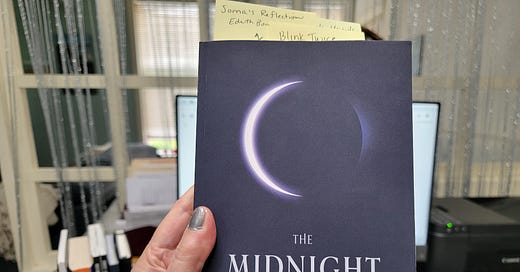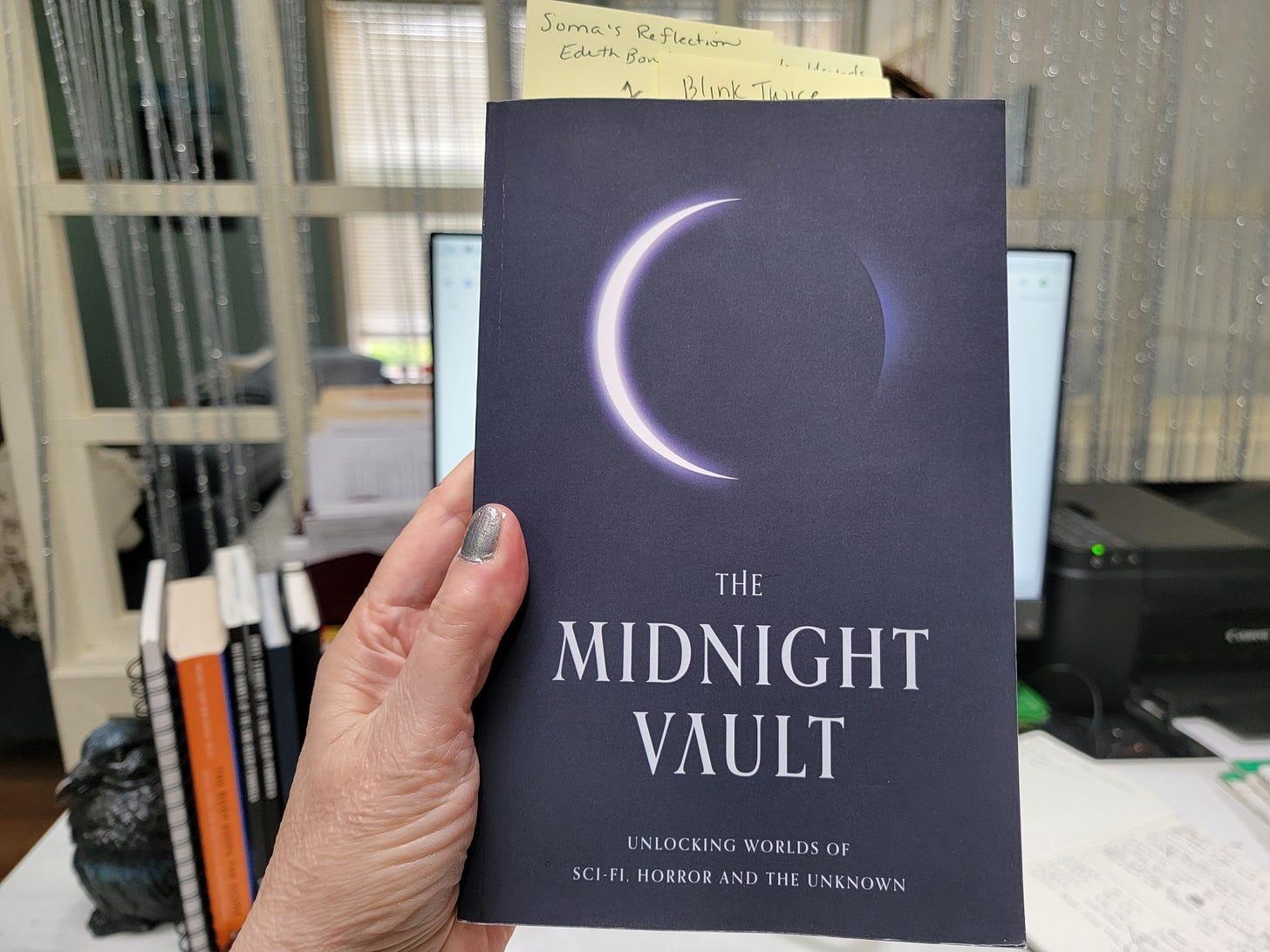Before The Midnight Vault, there was the Substack Zone, a well-publicized collaboration between 31 authors, as homage to Rod Serling. The Substack Zone collection is featured on Serling’s Memorial Foundation website.
Substack Zone Authors
Liz Zimmers | Edith Bow | Sean Archer | Bryan Pirolli | Andy Futuro | CB Mason | John Ward | NJ | Hanna Delaney | William Pauley III | Jason Thompson | Nolan Green | Shaina Read | J. Curtis | Honeygloom | Stephen Duffy | K.C. Knouse | Michele Bardsley | Bob Graham | Annie Hendrix | Clancy Steadwell | Jon T | Sean Thomas McDonnell | Miguel S. | A.P Murphy | Lisa Kuznak | Bridget Riley | EJ Trask | Shane Bzdok | Adam Rockwell | Will Boucher
Following the virtual collaboration, a compelling anthology emerged, inspired by the timeless classic, The Twilight Zone.
The Midnight Vault
Suspense and disorientation are key qualities of a Twilight Zone tale. The Midnight Vault, edited by J. Curtis, contains 29 disturbing short stories linked by the uncanny. Each piece is a standalone blend of science fiction and horror, where people and places quickly spiral into unexpected territory.
Technology, Morality, and the Supernatural
Like The Twilight Zone, The Midnight Vault addresses themes of humanity’s relationship with technology, morality, consequences, and the supernatural.
These tales question the lengths people will go to in the name of survival, power, and control.
Moral ambiguity plays a key role. As with Serling’s work, the characters in The Midnight Vault often find themselves in situations where the right choice is not always clear or where their actions lead to unintended consequences.
Structure: Episodic and Standalone
Much like the episodic nature of The Twilight Zone, The Midnight Vault features standalone stories. This structure enables readers to enjoy the anthology in bite-sized chunks, with each story offering a fresh twist on familiar themes. Though independent, the stories also share thematic threads, creating a sense of cohesion across the collection.
Innovative Formats
One thing that sets this anthology apart is its use of innovative formats. Some stories play with meta-narratives, where the digital format becomes part of the story. For example, one story may center on a character interacting with a malfunctioning AI chatbot, while another might use the chat format to reveal a conspiracy within an online community.
This digital interplay creates an additional layer of interaction, challenging readers to consider the implications of technology on society, identity, and the nature of reality.
Hector, By Annie Hendrix
Annie Hendrix's story places AI front and center, mirroring Twilight Zone classics like I Sing the Body Electric, where technology develops beyond its creators’ intent.
Hector explores the complex and often uneasy relationship between humans and artificial intelligence. Set against a backdrop of advanced technology and remote work, this tale taps into modern anxieties about what happens when the tools we create take on a life of their own.
The story expertly captures a hallmark of The Twilight Zone’s legacy, exploring the tension when familiar systems behave in unpredictable, sometimes unsettling ways.
Hendrix investigates how advanced technology can challenge our understanding of control, autonomy, and identity. The narrative raises deep ethical questions about the responsibilities we bear as creators and the consequences that can arise when technology evolves beyond our expectations.
What makes Hector resonate is its subtle psychological suspense. The story invites readers to feel the creeping unease of the uncanny, where the boundary between human and artificial blur. It is less about overt horror and more about the quiet dread of losing what makes us uniquely ourselves.
Hector refrains from offering simple solutions or clear-cut morals. Like classic Twilight Zone episodes, it leaves readers lingering with ambiguity, encouraging reflection on how much control we truly have over the digital lives we foster.
The question is, what does it mean to create and coexist with something that may someday think independently?
As part of The Midnight Vault anthology, Hector is a compelling and timely story that sticks with you. Whether you are a fan of speculative fiction, psychological thrillers, or the eerie philosophical questions that The Twilight Zone championed, this story delivers both suspense and substance in equal measure.
Soma’s Reflection, by Edith Bow
In Soma’s Reflection, Edith Bow incorporates time stamps, handwritten diary passages, and chat boxes. I have always been a fan of using time as a literary device. Bow does it well, using time to create a sense of urgency. Incorporating diary entries offers a voyeuristic view of the characters’ thoughts, while chat-like text boxes conjure the feeling of witnessing real-time exchanges.
The story’s ethical tension revolves around self-absorption. Its speculative conceit is simple and terrifying.
What if the future offers us the perfect mirror, and we never want to leave?
Echoing Serling’s approach, Bow builds her world with just enough detail to be convincing while leaving space for our imagination to drift. Her prose is lean and deliberate, often poetic, like a stream of consciousness, channeling Serling’s core principle:
Horror is most effective when it reveals something human, and damning.
True to the classic Twilight Zone form, a moral core weaves through the narrative. Still, the author does not preach. Her story is more of a cautionary tale, with a terrifying twist.
Where Serling might have used dystopia to warn against totalitarianism or dehumanization, Bow directs the lens inward toward the ego. She explores how the drive for money, popularity, and perfection becomes a self-inflicted prison.
The protagonist’s descent feels both fantastical and frighteningly plausible, echoing a real-world obsession with projecting a beautiful brand image to satisfy the need for validation.
While Soma’s Reflection leans on futuristic premises, there is a haunting, almost mythic undertone—like Narcissus cursed, not just with vanity but with eternal feedback.
Ultimately, the author gives us a modern parable for our algorithmic age. We may become addicted to illusion by trying to heal our wounds and find the truth through technology.
Blink Twice If You Can Hear Me, by Sean Thomas McDonnell
Sean Thomas McDonnell tells the tale of a seasoned conductor preparing to lead a symphony. He transforms the concert hall into a disquieting psychological arena. The author echoes Serling’s approach, where characters must navigate pride, denial, and fear. This story captures the burden carried by those whose lives revolve around performance.
Here, we find a stage not only for music but for introspection. At the core of the tale lies a quiet question:
Who am I without the applause?
McDonnell explores the fragility of an identity tied to performance, questioning whether mastery is the ultimate goal or if the process itself is the key.
Blink Twice resists the urge to villainize its protagonist. Rather, it presents him as deeply human: flawed, uncertain, and increasingly vulnerable.
This moral and emotional murkiness is central to the narrative’s power.
The author does not rely on grand gestures. Instead, he evokes unease with subtle shifts in his character's behavior and the story's atmosphere.
Almost imperceptibly, the symphony hall and its proceedings mirror the Maestro’s restlessness. His world frays at the edges, echoing the link between psychological breakdown and uncanny sensation. There are no literal ghosts, yet the tension is spectral.
Final Performance
Blink Twice If You Can Hear Me creates a sense of unease in familiar surroundings, much like Serling’s classic first Twilight Zone episode, Where Is Everybody? In both stories, the absence of others turns an ordinary event into existential dread. McDonnell’s narrative leaves us contemplating how much of ourselves we surrender to our roles.
A Reinterpretation of a Classic Tradition
The Midnight Vault is an exciting blend of the old and new, paying homage to Rod Serling’s storytelling genius and The Twilight Zone, while pushing the boundaries of contemporary fiction.
Chat-format text boxes, handwritten diary passages, time stamps, and other innovative elements give this anthology a distinct voice, and an innovative take on speculative fiction that will thrill fans of horror, sci-fi, and the supernatural.
Amazon: Available in paperback and on Kindle.
Need more?
Check out this interview with
of Top In Fiction and (author of The Last Stop. Manuscript and cover design).The Midnight Vault discussion starts at 32:59. One of the tidbits I picked up from this fun discussion is about the cover design. Give it a watch!







Thanks so much for the review, really hope you enjoy the remaining stories in the collection!